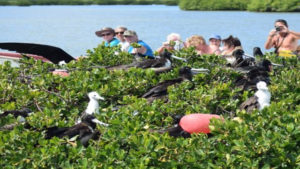 From lionfish to mongooses, and black rats to Giant African Snails, invasive species pose one of the greatest threats to the country’s ecosystems.
From lionfish to mongooses, and black rats to Giant African Snails, invasive species pose one of the greatest threats to the country’s ecosystems.
Not only can they decimate native plants and wildlife, they can deal an almighty economic blow too through losses to agriculture and fisheries.
Yesterday, the issue was once again brought to the fore as the globe marked World Wetlands Day, celebrated annually on February 2 to increase understanding of the critical role wetlands play.
Invasive species that pose a particular risk to local wetlands include Cuban tree frogs and the southern cattail plant, recognised by its long spikes with a brown cigar-looking stalk at the top. The plant grows quickly, is easily blown around, which helps propagate it, and has a suffocating effect on native flora.
Joseph Prosper, of the Department of Environment, urged contractors clearing land to take southern cattail to landfill sites.
“Cook’s Dump is the best place for it to go, rather than just leaving it on the side,” he told Observer.
Invasive southern cattail can have a suffocating effect on native flora (Photo courtesy Encyclopaedia of Life)
With no natural predators, invasive species are free to multiply and can rapidly become dominant.
“They are very dangerous because they have an impact on the gene pool of the various plants and animals that already exist there. They also disturb habitats and the availability of resources within an ecosystem,” he explained.
The project coordinator for invasive alien species said public awareness and education are key.
“Within the next month or two we will have a vigorous campaign on invasive alien species and what the public can do to help.
“It will require a community effort. Government departments are doing what they can. It’s got to the point where the different villages and community groups need to come together and bring in experts from government, the private sector or overseas to show people how best to manage and detect them,” Prosper added.
Meanwhile, the Department of Environment has already created resource guides for schools on mangrove ecosystems and is now developing a guide on how residents can tackle invasive species.
“We are also developing an app to provide information on invasive species, allow people to report sightings and get educational content too,” said senior environmental officer Daryl George.
Other efforts aimed at protecting local wetlands include the imposition of stiff fines – increased in 2019 – for dumping waste in them, George said, adding an appeal to witnesses to report such incidents to the Ministry of Health and Environment.
Wetlands are described as distinct ecosystems that are flooded by water, either permanently or seasonally, such as marshes, swamps and bogs. In addition to providing habitat for wildlife, they contribute to biodiversity and climate change mitigation, and help reduce damage from storms.
Wednesday’s international observance has a special significance in Antigua and Barbuda where several of the country’s 36 wetlands face the additional threat posed by development. They include the nation’s largest wetland, dubbed The Flashes, which falls within the confines of the special economic zone between Jennings and Five Islands, and the Codrington Lagoon in Barbuda, adjacent to the controversial Peace, Love and Happiness project.
Globally, almost 90 percent of the world’s wetlands have been degraded since the 1700s, meaning wetlands are being lost three times faster than forests.
Eight reasons why wetlands are important
Wetlands purify our water by trapping sediments and removing pollutants.
· Wetlands store our water to ensure supply during dry periods. Like giant sponges, they store water and then slowly release it, and this helps to deal with dry spells.
